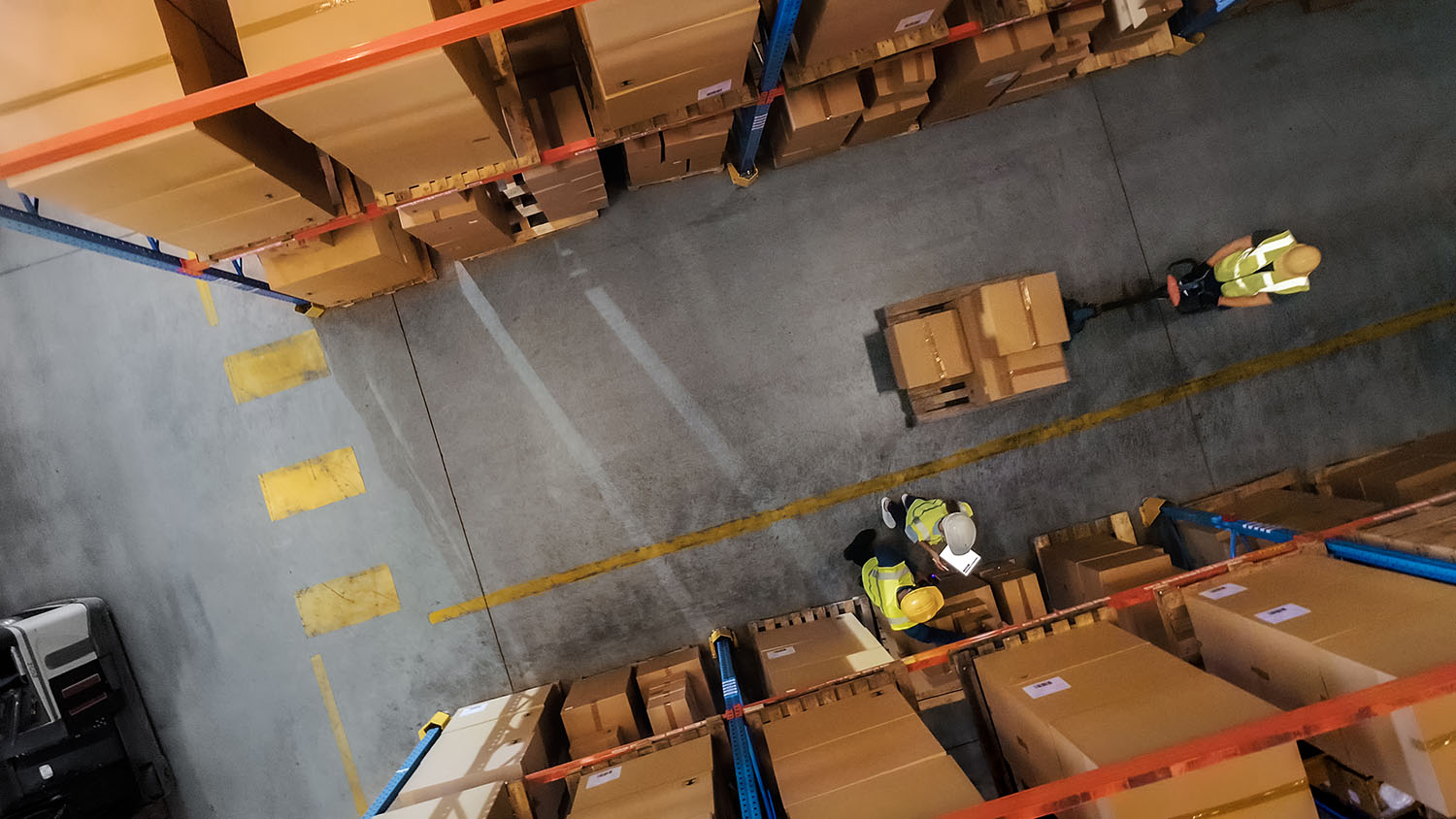Supply chain complexity keeps climbing: more channels, soaring SKU counts, and shrinking delivery promises.
Analysts see the global WMS market expanding at 19.9% annually from 2025 to 2030, a clear sign that supply chain professionals need more comprehensive control over their warehouse fulfillment operations.
For 3PLs, that control starts with a cloud-ready, fully configurable warehouse management system.
The Evolving Landscape of 3PL Warehouse Management
International trade moves more rapidly in every direction, and each new link in the chain drags fresh rules, tariffs, and carrier constraints into the warehouse.
One hour you’re wrapping full pallets for a wholesale buyer in Brussels; the next you’re labelling single-unit TikTok orders bound for Jakarta, each with unique duty codes, return labels, and branded packaging inserts.
These rapid product launches collide with customer demands for near-instant tracking updates that match consumer apps down to the minute, a level of transparency once most often seen in 3PL vs. 4PL partnerships.
Technological leaps add another layer. Robotics, computer vision, and artificial intelligence promise lower costs, yet they only deliver when real‑time data flows freely across systems.
Brands fund this tech because shoppers want faultless order accuracy and doorstep speed, and the quickest way to disappoint those shoppers is with stale or siloed inventory data.
A flexible platform lets operators plug innovations in without rewriting the core code of the WMS, while elastic cloud resources flex during peak season and compress afterwards to trim overhead.
Mounting legislative pressures — ranging from carbon reporting and recycled packaging mandates to country‑of‑origin audits — push new data fields and workflows into daily operations.
Venture‑backed ecommerce sellers, flush with ad spend, expect onboarding in days and won’t wait for IT to code new billing rules. Boot-strapped startups are equally demanding. So 3PLs have no choice but to grade WMS partners by the pace the warehouse can make changes, viewing a static system as too inflexible to drive growth in their customer base.
Success for 3PLs now hinges on live insight and rule‑level agility. Warehouse leaders track tight inventory management KPIs such as dock‑to‑stock time, pick accuracy, and cost per unit picked, knowing every missed metric risks a chargeback or social‑media firestorm.
Only a configurable, cloud‑based WMS can juggle these moving targets while still pushing throughput higher — turning chaos into margin instead of headaches.
Pain Points in 3PL Warehouse Management
Meeting service promises while defending margin means staring down the same five pain points every day. Each challenge is persistent, interlinked, and costly when ignored.
A modern, flexible WMS gives operators the tools to turn these hurdles into competitive advantages.
Inaccurate Inventory
High‑volume, multichannel facilities can touch a single SKU dozens of times daily, multiplying the chance of a bad scan. When on‑hand counts slip, planners rush emergency buys, and pickers waste minutes chasing empty slots. Real‑time barcode or RFID validation at every touch, paired with exception‑driven cycle counts, keeps inventory truthful and supports lean inventory management strategies like cross‑docking without risking stockouts.
Order Fulfillment Slowdowns
Shoppers see “fast” as “same day,” and brands push that promise to their logistics partners. Manual wave planning, paper pick lists, and ad‑hoc pack stations turn orders into overnight backlogs. Dynamic wave algorithms, cart picking, and cartonization slash walking, remove extra touches, and maintain accuracy, helping teams clear more lines with the same headcount.
Scalability blockages
Each new customer brings unique kitting, compliance, or billing needs that can expose rigid code and siloed reports. When IT backlogs stall onboarding, revenue stalls too. Superuser‑friendly configuration lets teams create workflows, documents, and billing tables on the fly, while cloud resources scale so the first carton moves as smoothly as the millionth.
Ballooning Operational Costs
Labor, parcel surcharges, and facility rent keep rising, squeezing profit margins thin. Long travel paths, lagging replenishment, or missed accessorial fees make costs balloon even faster. Task‑level labor tracking highlights waste down to the aisle, and automated 3PL billing captures storage, picks, and value‑adds instantly—hallmarks of 3PL best practices that protect margin without extra staff.
Client Dissatisfaction
Brands have zero tolerance for surprises; a late pallet can derail a promotion, and one mislabeled parcel can flood social feeds. Live dashboards and exception alerts surface issues before they snowball, while client portals deliver self‑service visibility that calms nerves. Consistent performance against strict KPIs builds trust, drives renewals, and turns reliable 3PL fulfillment into a growth engine.
Strategic Advantages of Flexible WMS for 3PL
A configurable, cloud‑first platform doesn’t just plug gaps; it creates space to scale and innovate.
It lets warehouse leaders align processes with client needs in real time, pull actionable insights from live data, and unlock new revenue streams without rewriting code. Below are the core payoffs that operators can bank on when they adopt a truly adaptable WMS.
- Sharper Inventory Management: Every receipt, move, and ship event feeds a single source of truth visible to planners and pickers alike. Directed putaway uses velocity, temperature, or hazard rules to land items in the right slot on the first touch, and exception‑driven counts sustain near‑perfect accuracy. Together, these capabilities support lean stock levels, healthier cash flow, and stronger inventory management KPIs.
- Accelerated Order Flow: Dynamic wave planning groups orders by carrier, promise time, or pick zone, then maps the shortest route through the building. Cart picking combines dozens of orders in one trip, and cartonization chooses the right box while printing compliant labels automatically. These steps shrink dock‑to‑door time, satisfy demanding SLAs, and prove you’re navigating 3PL challenges with cloud-based WMS instead of fighting them.
- Revenue‑Safe Billing: Storage, picks, kitting, and discretionary fees post to invoices as they happen, tailored to each client’s contract. Automated billing eliminates spreadsheet reconciliations, slashes dispute cycles, and reveals profitable value‑added services you can upsell. Solid billing hygiene is a decisive edge when choosing a 3PL WMS that must pay for itself quickly.
- Actionable Analytics: Dashboards translate scan events into metrics operators can act on now—travel time by zone, dwell time by SKU, and labor cost per unit. Early warnings let supervisors coach in real time rather than dissect yesterday’s misses. Data transparency empowers every layer of management to pursue continuous improvement with confidence.
- Elastic Growth: Cloud infrastructure flexes up for Black Friday peaks and down for January lulls, so capacity bills track volume instead of sitting fixed and high year‑round. New buildings, clients, or automation plug in through configuration, cutting time‑to‑revenue and future‑proofing operations.
Integration With Other Systems
More than half of supply‑chain executives rank end‑to‑end visibility as their top priority, and that goal lives or dies on tight, real‑time connections across every application in the stack.
WMS integration is the spine that delivers those connections, turning raw scans into live, shared truth the instant a pallet hits the dock. Da Vinci brings that connectivity to the warehouse floor and then pushes it out to finance, ecommerce, carrier portals, and automation gear.
Inside the four walls, one database powers cross‑docking, directed putaway, cart picking, cartonization, and wave planning; the same tables feed Yard, Transportation, and Labor modules so dock appointments, freight rates, and engineered standards stay in sync.
The challenge has always been knitting that live data into dozens of outside systems without months of custom code. The platform solves that challenge in four practical ways:
Out‑of‑the‑box connectors
Fifty‑plus pre‑built links snap into leading ERPs, parcel systems, EDI hubs, and high‑volume marketplaces. A new Shopify or Amazon storefront can stream orders in minutes, keeping launches smooth and margins intact.
Self‑service integration store
Superusers browse an in‑app marketplace, pick a connector, and walk through a mapping wizard to set field rules and sync cadence. No ticket queue, no developer sprint—just rapid alignment that keeps client onboarding on schedule.
Open REST API and event webhooks
For bespoke tools—forecast models, branded tracking portals, BI dashboards—developers tap a clean API while webhooks push events the moment they happen. Inventory hits the dock, a carton closes, a trailer departs; each step posts automatically, powering navigating 3PL challenges with cloud-based WMS instead of coping with batch delays.
Material‑handling and robotics hooks
Conveyors, AS/RS cranes, AMRs, and put‑wall lights pull tasks straight from the core tables and return confirmations without middleware. People and machines run on the same clock, slashing dwell time and sustaining throughput at peak.
Elastic cloud resources keep query latency low even on Cyber Monday, so dashboards refresh in real time and rate‑shopping APIs never stall. Integration specialists stand ready for edge cases: they tune data maps, stress‑test message volume, and stay on call after go‑live.
The result is a network of applications that behaves like one system, driving faster picks, tighter billing, and happier clients—all proof that a modern, cloud WMS can stitch an entire supply chain together and sustain growth without tripping over its own data.
Start Turning Complexity into Profit
Standing still is the quickest route to lost clients and eroded margins.
A configurable, cloud‑first WMS equips 3PLs to reshape workflows, integrate new tech, and guard profitability — no matter how wild demand swings.
Da Vinci’s platform packs cartonization, directed putaway, advanced waves, and automated 3PL billing into tools your team can control without a developer.
Those gains show up fast: fewer chargebacks, tighter labor spend, and billing that captures every penny of value‑add. Teams reclaim hours once wasted on manual reports, using the time to win new accounts instead.
Schedule a demo and watch your warehouse flex as fast as your customers change.



